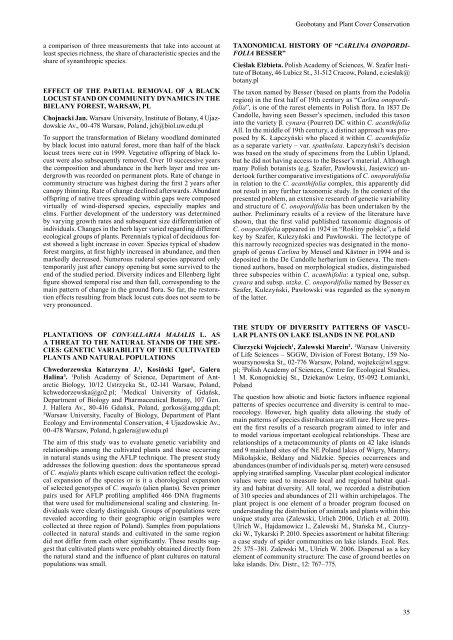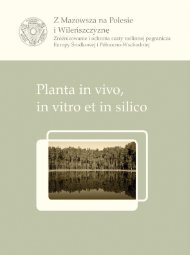acta societatis botanicorum poloniae - LV Zjazd Polskiego ...
acta societatis botanicorum poloniae - LV Zjazd Polskiego ...
acta societatis botanicorum poloniae - LV Zjazd Polskiego ...
Create successful ePaper yourself
Turn your PDF publications into a flip-book with our unique Google optimized e-Paper software.
a comparison of three measurements that take into account at<br />
least species richness, the share of characteristic species and the<br />
share of synanthropic species.<br />
EFFECT OF THE PArTIAL rEMOVAL OF A BLACK<br />
LOCUST STANd ON COMMUNITY dYNAMICS IN THE<br />
BIELANY FOrEST, WArSAW, PL<br />
Chojnacki Jan. Warsaw University, Institute of Botany, 4 Ujazdowskie<br />
Av., 00-478 Warsaw, Poland, jch@biol.uw.edu.pl<br />
To support the transformation of Bielany woodland dominated<br />
by black locust into natural forest, more than half of the black<br />
locust trees were cut in 1999. Vegetative offspring of black locust<br />
were also subsequently removed. Over 10 successive years<br />
the composition and abundance in the herb layer and tree undergrowth<br />
was recorded on permanent plots. Rate of change in<br />
community structure was highest during the first 2 years after<br />
canopy thinning. Rate of change declined afterwards. Abundant<br />
offspring of native trees spreading within gaps were composed<br />
virtually of wind-dispersed species, especially maples and<br />
elms. Further development of the understory was determined<br />
by varying growth rates and subsequent size differentiation of<br />
individuals. Changes in the herb layer varied regarding different<br />
ecological groups of plants. Perennials typical of deciduous forest<br />
showed a light increase in cover. Species typical of shadow<br />
forest margins, at first highly increased in abundance, and then<br />
markedly decreased. Numerous ruderal species appeared only<br />
temporarily just after canopy opening but some survived to the<br />
end of the studied period. Diversity indices and Ellenberg light<br />
figure showed temporal rise and then fall, corresponding to the<br />
main pattern of change in the ground flora. So far, the restoration<br />
effects resulting from black locust cuts does not seem to be<br />
very pronounced.<br />
PLANTATIONS OF convAllAriA mAjAlis L. AS<br />
A THrEAT TO THE NATUrAL STANdS OF THE SPE-<br />
CIES: GENETIC VArIABILITY OF THE CULTIVATEd<br />
PLANTS ANd NATUrAL POPULATIONS<br />
Chwedorzewska Katarzyna J. 1 , Kosiński Igor2 , Galera<br />
Halina3 . 1Polish Academy of Science, Department of Antarctic<br />
Biology, 10/12 Ustrzycka St., 02-141 Warsaw, Poland,<br />
kchwedorzewska@go2.pl; 2Medical University of Gdańsk,<br />
Department of Biology and Pharmaceutical Botany, 107 Gen.<br />
J. Hallera Av., 80-416 Gdańsk, Poland, gorkos@amg.gda.pl;<br />
3Warsaw University, Faculty of Biology, Department of Plant<br />
Ecology and Environmental Conservation, 4 Ujazdowskie Av.,<br />
00-478 Warsaw, Poland, h.galera@uw.edu.pl<br />
The aim of this study was to evaluate genetic variability and<br />
relationships among the cultivated plants and those occurring<br />
in natural stands using the AFLP technique. The present study<br />
addresses the following question: does the spontaneous spread<br />
of C. majalis plants which escape cultivation reflect the ecological<br />
expansion of the species or is it a chorological expansion<br />
of selected genotypes of C. majalis (alien plants). Seven primer<br />
pairs used for AFLP profiling amplified 466 DNA fragments<br />
that were used for multidimensional scaling and clustering. Individuals<br />
were clearly distinguish. Groups of populations were<br />
revealed according to their geographic origin (samples were<br />
collected at three region of Poland). Samples from populations<br />
collected in natural stands and cultivated in the same region<br />
did not differ from each other significantly. These results suggest<br />
that cultivated plants were probably obtained directly from<br />
the natural stand and the influence of plant cultures on natural<br />
populations was small.<br />
Geobotany and Plant Cover Conservation<br />
TAxONOMICAL HISTOrY OF “cArlinA onoPordifoliA<br />
BESSEr”<br />
Cieślak Elżbieta. Polish Academy of Sciences, W. Szafer Institute<br />
of Botany, 46 Lubicz St., 31-512 Cracow, Poland, e.cieslak@<br />
botany.pl<br />
The taxon named by Besser (based on plants from the Podolia<br />
region) in the first half of 19th century as “Carlina onopordifolia”,<br />
is one of the rarest elements in Polish flora. In 1837 De<br />
Candolle, having seen Besser’s specimen, included this taxon<br />
into the variety β. cynara (Pourret) DC within C. acanthifolia<br />
All. In the middle of 19th century, a distinct approach was proposed<br />
by K. Łapczyński who placed it within C. acanthifolia<br />
as a separate variety – var. spathulata. Łapczyński’s decision<br />
was based on the study of specimens from the Lublin Upland,<br />
but he did not having access to the Besser’s material. Although<br />
many Polish botanists (e.g. Szafer, Pawłowski, Jasiewicz) undertook<br />
further comparative investigations of C. onopordifolia<br />
in relation to the C. acanthifolia complex, this apparently did<br />
not result in any further taxonomic study. In the context of the<br />
presented problem, an extensive research of genetic variability<br />
and structure of C. onopordifolia has been undertaken by the<br />
author. Preliminary results of a review of the literature have<br />
shown, that the first valid published taxonomic diagnosis of<br />
C. onopordifolia appeared in 1924 in “Rośliny polskie”, a field<br />
key by Szafer, Kulczyński and Pawłowski. The lectotype of<br />
this narrowly recognized species was designated in the monograph<br />
of genus Carlina by Meusel and Kästner in 1994 and is<br />
deposited in the De Candolle herbarium in Geneva. The mentioned<br />
authors, based on morphological studies, distinguished<br />
three subspecies within C. acanthifolia: a typical one, subsp.<br />
cynara and subsp. utzka. C. onopordifolia named by Besser ex<br />
Szafer, Kulczyński, Pawłowski was regarded as the synonym<br />
of the latter.<br />
THE STUdY OF dIVErSITY PATTErNS OF VASCU-<br />
LAr PLANTS ON LAKE ISLANdS IN NE POLANd<br />
Ciurzycki Wojciech 1 , Zalewski Marcin 2 . 1 Warsaw University<br />
of Life Sciences – SGGW, Division of Forest Botany, 159 Nowoursynowska<br />
St., 02-776 Warsaw, Poland, wojtekc@wl.sggw.<br />
pl; 2 Polish Academy of Sciences, Centre for Ecological Studies,<br />
1 M. Konopnickiej St., Dziekanów Leśny, 05-092 Łomianki,<br />
Poland<br />
The question how abiotic and biotic factors influence regional<br />
patterns of species occurrence and diversity is central to macroecology.<br />
However, high quality data allowing the study of<br />
main patterns of species distribution are still rare. Here we present<br />
the first results of a research program aimed to infer and<br />
to model various important ecological relationships. These are<br />
relationships of a metacommunity of plants on 42 lake islands<br />
and 9 mainland sites of the NE Poland lakes of Wigry, Mamry,<br />
Mikołajskie, Bełdany and Nidzkie. Species occurrences and<br />
abundances (number of individuals per sq. meter) were censused<br />
applying stratified sampling. Vascular plant ecological indicator<br />
values were used to measure local and regional habitat quality<br />
and habitat diversity. All total, we recorded a distribution<br />
of 310 species and abundances of 211 within archipelagos. The<br />
plant project is one element of a broader program focused on<br />
understanding the distribution of animals and plants within this<br />
unique study area (Zalewski, Urlich 2006, Urlich et al. 2010).<br />
Ulrich W., Hajdamowicz I., Zalewski M., Stańska M., Ciurzycki<br />
W., Tykarski P. 2010. Species assortment or habitat filtering:<br />
a case study of spider communities on lake islands. Ecol. Res.<br />
25: 375– 381. Zalewski M., Ulrich W. 2006. Dispersal as a key<br />
element of community structure: The case of ground beetles on<br />
lake islands. Div. Distr., 12: 767– 775.<br />
35



